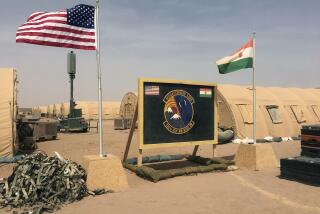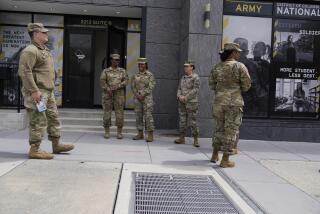U.S. Military in Bosnia Beats a Hasty . . . Reshaping
- Share via
CAMP PAT, Bosnia-Herzegovina — In a lush Serb-held valley in eastern Bosnia, U.S. soldiers Saturday rolled up the barbed-wire perimeter of their base camp, folded tents and loaded huge containers of equipment onto flatbed trucks.
A company of tanks had clambered out a few hours earlier, and infantry platoons were to follow today.
At breakneck speed, Camp Pat was being dismantled, the first American base to close as part of a major restructuring of the U.S. peacekeeping force in Bosnia-Herzegovina.
With an eye on Bosnia’s elections next month and the eventual withdrawal of North Atlantic Treaty Organization-led forces, much of the U.S. contingent’s heavy armor--its tanks and largest artillery--is being replaced by military police in Humvees, the less cumbersome armored jeeps made famous in Desert Storm.
Despite the lessened firepower, U.S. officials here and in Washington insist that the Army’s 1st Armored Division, which patrols the northeast quadrant of Bosnia, will remain sufficiently well-armed to fend off any challenge to its authority from this country’s former enemy factions.
But the mission is changing, and so must the army that is fulfilling it, the officials say.
The reshaping, as it is known, will make the U.S. contingent here less of a combat-ready force andmore of a quasi-police force.
The reshaping is also the first step in preparations for the expected arrival after Dec. 20 of a follow-on force that will replace the NATO contingent when its yearlong Bosnia deployment ends.
When nearly 20,000 American troops joined a 40,000-strong NATO force in December to enforce a U.S.-brokered peace agreement in Bosnia, a powerful show of force was necessary to intimidate Bosnia’s Serbs, Croats and Muslims into compliance, U.S. officials say.
Military planners expected pockets of resistance. But little materialized, the enemy armies have been separated, and a lighter, more mobile force is considered better to handle a job that will now involve election security, rebuilding and the overseeing of refugees trying to cross ethnic lines to vote or go home.
But concerns have also been raised that the transformation could send a troublesome signal to recalcitrant Bosnians tempted to see a lighter U.S. force as less of a deterrent to renewed warfare.
Here at Camp Pat, as well as in Washington, such concerns were dismissed.
“I don’t think they will want to mess with us,” said Capt. John Chaput of North Andover, Mass. “They’ll push and try to get as much as they can. But they know what we can do to them. We know their sites, we know their bases. They attack us, and we will pound them.”
*
Yet security fears forced Camp Pat to accelerate its tear-down, officers said.
Built over a four-month period in a river valley about an hour’s drive southeast of Tuzla, Camp Pat was scheduled to be dismantled according to a 35-day plan. But the orders came last week to finish the task in five days, resulting in what one officer described as controlled chaos.
The tear-down was speeded up after a recent flare-up of defiance from the Bosnian Serb army at its nearby headquarters in Han Pijesak, where indicted war crimes suspect Gen. Ratko Mladic, the army commander, is based.
In a standoff that sent NATO troops into high alert, Serbs refused to allow NATO military inspectors into an arms-collection site. They are bound to do so under the peace accord, and they later relented.
Not easy to defend, Camp Pat would have been vulnerable to Bosnian Serb retaliation if NATO had attacked the defiant Serbs, officers said.
Maj. Tony Turner, executive officer of the 4-12 Infantry Battalion based at Camp Pat, said he is confident that although fewer U.S. troops will be based in the Bosnian Serb sector of the country, the American military will maintain its presence through quicker, more flexible patrols.
The Americans will lose more than two-thirds of their tanks, 20% of their Bradley fighting vehicles and all of their multiple-launch rocket systems while retaining all 50 of their 155-millimeter howitzers. Humvees will double, to 422, and the Americans will still have Apache helicopter gunships in the theater, U.S. military officials said.
The logistics nightmare that awaits an eventual pullout of American troops was evident at Camp Pat on Saturday.
The site was once nothing but a cornfield, but U.S. engineering ingenuity and tons of gravel had created a mini-city with hot running water, electricity, Nautilus weight machines, pool tables and parking lots for the tanks and armored vehicles.
“What we have to do is get it back to where it was before. We’re almost there,” said Chaput, who planned the tear-down.
Around him, muddy patches were left where the living quarters once sat, and stacks of sandbags waited their turn to be transported out.
Local landowners have expressed interest in retaining the road that the Americans built through Camp Pat even though it dissects fertile farmland, and that is under negotiation.
*
Camp Lisa, the U.S. Army’s largest base in the Bosnian Serb sector, at Vlasenica, will be torn down within the next month or so.
In all, the first stage of the reshaping will replace two battalions of armored units with two battalions of military police.
A first company of MPs, from Ft. Polk, La., crossed the Sava River from Croatia into Bosnia on Saturday.
The 2-68 Armored Battalion--which includes the tanks that pulled out of Camp Pat--will move to another base near Tuzla and in a few days will cross the Sava River in the other direction, en route to Hungary, before deployment back to Germany.
Initially, the Clinton administration had hoped to begin pulling units back to Germany earlier, but with elections postponed until mid-September, the pullout is not likely to get underway in earnest until late September or early October, Pentagon officials said.
Administration officials have been reluctant to admit that a follow-on force will be necessary.
But with the political side of pacifying Bosnia lagging far behind the military success, most analysts agree not only that one is necessary but that NATO has already begun the planning. The follow-on force will possibly have about 40,000 members, or about two-thirds of the total now involved in the Bosnia mission.
The United States’ European allies have also made it clear that if the Americans pull out completely, so will they, and peace would almost certainly collapse.
At Camp Pat, infantryman Cesar Martinez of Los Angeles agreed.
“I think with NATO here, with the Americans here, they [the Bosnians] are all pretty intimidated,” he said, taking a break from packing up camp. “But once we are gone, I think they’ll go right back to the way they were.”
Wilkinson reported from Camp Pat and Pine from Washington.
More to Read
Sign up for Essential California
The most important California stories and recommendations in your inbox every morning.
You may occasionally receive promotional content from the Los Angeles Times.











